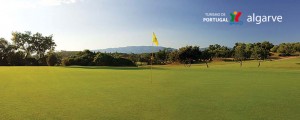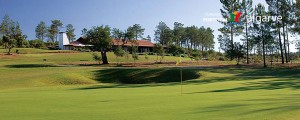CS Morgado Course Review
North of the beaches at Portimão in the Algarve, nestled in the foothills of the Monchique Mountains, is CS Morgado. A relatively new addition to the Algarve golfing landscape, Morgado is rapidly maturing into a quality golfing destination that succeeds in blending the challenge of a championship course with the demands of holiday golf.
The Experience
The CS Morgado Resort feels distinctly different to other golfing destinations in the region. Set back from the coast and blending seamlessly with its rural setting, at times playing Morgado feels more like taking a stroll through the Portuguese countryside, complete with olive trees, hoopoes and views away to the picturesque hills. This is an attractive side to the Algarve that is too easily overlooked by tourists flocking straight to the beaches, and while the facilities at CS Morgado are anything but basic (in fact, they are ultra‐modern), the resort exudes a relaxed, back‐to‐nature contentment that can be a very welcome change of scene.
 The ambience of the quiet and stylish clubhouse is worth absorbing, as you lounge in comfortable chairs on a shaded terrace that adds a touch of opulence to your post‐round drink. Here you can look out and admire a course that sits comfortably in its traditional surrounds, and gaze at a deep blue sky punctuated only by the occasional passing of a brilliant‐white egret. This experience is about more than just golf.
The ambience of the quiet and stylish clubhouse is worth absorbing, as you lounge in comfortable chairs on a shaded terrace that adds a touch of opulence to your post‐round drink. Here you can look out and admire a course that sits comfortably in its traditional surrounds, and gaze at a deep blue sky punctuated only by the occasional passing of a brilliant‐white egret. This experience is about more than just golf.
CS Group is the fastest growing hotel group in Europe and the investment at the CS Morgado Golf Resort, with its two five star hotels on‐site (yes, two!), is plain for all to see. The first of these, the CS Morgado Golf Hotel, is now open for golfers looking to stay and play both courses, and while construction continues on the estate, it’s only really in evidence in the distance and on driving in and out of the resort.
Location
While further inland than most of the courses in the region, the CS Morgado Golf Resort’s central position in the Algarve makes it an excellent base for golfers getting away from the more famous and expensive destinations around Faro (courtesy of the A22, the drive from Villamoura and Quinta do Lago now takes less than 30 minutes). And with the Álamos course providing a very different but no less enjoyable test on the opposite side of the clubhouse, this is an off‐the‐beaten‐track destination that’s well worth a detour.
The Course
As the longer of the resort’s two eighteen hole courses (the other, Álamos, opened for play in March 2006), Morgado is a European Golf Design layout that stretches to a formidable 6,399 metres (7,040 yards) off the championship tees. Thankfully, played from the forward tees, it is a somewhat easier proposition and you can set about enjoying a challenging rather than humiliating golfing experience. After all, you’ve headed to the Algarve to play golf in the warmth of the Iberian sun, not to search for balls in waist‐high undergrowth.
That’s not to say that Morgado could ever be classified as easy, especially given the prevailing wind that seems to blow against you more often than not. It’s perhaps worth mentioning that the breeze can be deceptively cooling and, with little shade to be had out on the course, it’s worth making sure you have plenty of sun lotion and water with you. Taking a buggy is the advisable option.
Front 9
Having loosened up on the driving range (a satisfying experience in itself given the peacefulness of the location and quality of the facility), a relatively gentle opening par four awaits. The out‐ofbounds is far enough right not to worry most and there’s plenty of room left if your three‐wood doesn’t fade as much as you’d planned, given the soft left‐to‐right shape of the hole.
Be warned, Morgado isn’t short of fairway bunkers but if you can plot your way between them successfully, you’ll likely to be on for a good score. The greens are large, very large on occasion, so judging the distance on your approach shot is perhaps more important here than at most courses. At times you could knock it on and still be faced with a 30 yard putt – not for the faint‐hearted!
 The second hole plays much the same as the first, albeit demanding a longer approach shot, and you’ll be relieved to have a couple of pars under your belt when you step on to the third tee and see what awaits. If ever you had to commit to a confident swing, this is it. In truth, the landing area is quite sizeable but with out‐of‐bounds the full length of the hole on the right and water lining the fairway on the left, there’s little room for error. Get a good drive away and the wind is still likely to keep the green well out of reach for all but Alberto Quiros. Playing 535 metres (roughly 580 yards) into the wind, this is a monster of a hole that you’re simply looking to par and move on.
The second hole plays much the same as the first, albeit demanding a longer approach shot, and you’ll be relieved to have a couple of pars under your belt when you step on to the third tee and see what awaits. If ever you had to commit to a confident swing, this is it. In truth, the landing area is quite sizeable but with out‐of‐bounds the full length of the hole on the right and water lining the fairway on the left, there’s little room for error. Get a good drive away and the wind is still likely to keep the green well out of reach for all but Alberto Quiros. Playing 535 metres (roughly 580 yards) into the wind, this is a monster of a hole that you’re simply looking to par and move on.
The next offers a little respite. Again the water plays down your left side, but a good strike will take most beyond it and into relative safety, whether on the fairway or off it. But don’t stray too far right or you’ll be in considerable trouble, with the possibility of having to reload. If you stay on the straight and narrow you’ll be left with a short iron but clubbing is vital into this particularly deep green. The fourth is the first short hole of the day, though not that short at 209 metres (230 yards) off the back tees. There’s a stream bisecting the hole but if you’ve chosen the right club and struck it well enough, you’ll be well clear. Up at the green, though, this is no easy two putt, with the wide and undulating green demanding a well judged approach putt.
Five and six head up and back down, either side of a stream that runs down the left side of both. Take particular care on the fifth as the water cuts into the fairway around the landing area more than you can see from the tee. A decent drive makes for a relatively easy hole but with out‐of bounds right, a straight drive is imperative.
The sixth, a par five, allows you to open your shoulders, with anything right of target still offering a straightforward shot back into play. That’s unless you’re particularly unlucky and find yourself up against one of the indigenous trees that are attractively dotted around. Longer hitters may fancy their chances of getting up in two but the raised green will discard all but the perfect approach.
The eighth is a good par three that plays uphill to another enormous green, before you launch your drive back towards the clubhouse on the ninth. At 282 metres, this is driveable for some, but for most you’re left with a short but knee‐trembling pitch shot onto a green that’s greatest protection is the audience watching from the clubhouse terrace. If you’ve driven it on, you’ll take pleasure in strolling up the fairway, putter in hand.
Back 9
As enjoyable as the front nine is, the back nine is what makes Morgado memorable. From your tee shot on the tenth, you begin to climb into the hills and will be grateful for your buggy. The raised tees and undulating fairways create a more distinct and impressive collection of holes that wind their way into the countryside before turning back (and downhill) for home.
The tenth is an uphill par five that dog‐legs gently away right‐to left at the end. This is an appealing drive with plenty of room (if you miss the bunkers!), set against a traditionally bucolic vista. For the vast majority, this is a good three‐shotter, so leave yourself with your favourite wedge distance to give yourself a birdie chance.
A short but pretty par three rewards your climb to the top of the hill. Exposed to the wind, picking the right club is probably harder than the shot itself. Get it wrong and you’ll be left with a devilishly tricky second, wherever you finished up. Strategy is key at the twelfth as you decide whether to hit a long iron onto a fairway that cuts diagonally between a plethora of bunkers or launch a driver and hope you clear them. There’s no way back from the desert terrain that visually erodes the hole from the left, so hit driver at your peril. Your approach to the green above you is difficult to judge, though there’s a little bit of space behind the green so long is probably better than short. Not too long though!
 The thirteenth is, to my mind at least, the best hole on the course. A risk or reward par five that plays along the spine of the highest point on the course, you stand on the tee faced by a snaking fairway that disappears over the crest of the hill. Left is dead and everything pushes you right, down to equally penal scrubland. A good drive, evading the well‐placed fairway bunker leaves you contemplating a long but inviting second, down the hill to a narrow green that sits atop the next undulation. There’s nowhere to miss, so layup or hit it very straight. Or just go for it and keep your fingers crossed – what the hell, you’re on holiday, aren’t you?
The thirteenth is, to my mind at least, the best hole on the course. A risk or reward par five that plays along the spine of the highest point on the course, you stand on the tee faced by a snaking fairway that disappears over the crest of the hill. Left is dead and everything pushes you right, down to equally penal scrubland. A good drive, evading the well‐placed fairway bunker leaves you contemplating a long but inviting second, down the hill to a narrow green that sits atop the next undulation. There’s nowhere to miss, so layup or hit it very straight. Or just go for it and keep your fingers crossed – what the hell, you’re on holiday, aren’t you?
The next tee shot is an enjoyable launch from a raised tee down to a fairway that sweeps across you to the right. It’s imperative not to bite off more than you can chew and the elevation tends to foreshorten the distance visually, so take care. From the centre of the fairway you’re still faced by an imposing approach to a green abutted on the left by a lake that grows in size every second you stand over your shot.
The fifteenth is a short but attractive uphill hole, fringed by olive trees, before you embark on the sixteenth which is a long par five that welcomes a tee shot struck with wild abandon. That said, it helps if you keep it on the short stuff. Like most of the par fives at Morgado, into the wind this plays as a good three‐shot hole, so don’t be too greedy as there’s plenty of trouble up by the green.
The penultimate hole is a good‐looking downhill par three that, depending on the wind, can be anything from a mid‐iron to a wood. Take a par and move on to the last, with its spectacular view down the hill to the clubhouse and beyond to the vineyards of Reguengo. Like so many holes at Morgado, the eighteenth is all about the tee shot: hit a good one and you’ll have a mid‐iron just waiting to be struck to the middle of the green, en route to a rewarding chilled bottle of Sagres on the terrace.